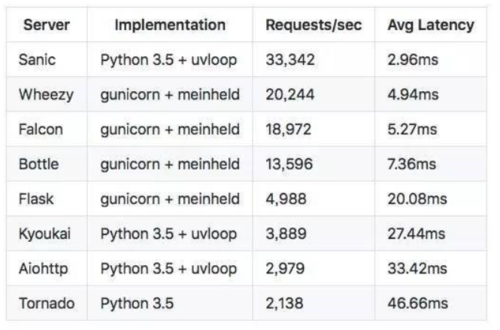简介
Sanic 是一个和类Flask 的基于Python3.5+的web框架,它编写的代码速度特别快。
除了像Flask 以外,Sanic 还支持以异步请求的方式处理请求。这意味着你可以使用新的 async/await 语法,编写非阻塞的快速的代码。
关于 asyncio 包的介绍,请参考之前的一篇文章 python并发2:使用asyncio处理并发
Github 地址 是 https://github.com/channelcat/sanic,感兴趣的可以去贡献代码。
既然它说速度特别快,我们先看下官方提供的 基准测试结果。
Sanic基准测试
sanic benchmarks
这个测试的程序运行在 AWS 实例上,系统是Ubuntu,只使用了一个进程。
Sanic 的开发者说他们的灵感来自于这篇文章 uvloop: Blazing fast Python networking。
那我们就有必要看下uvloop是个什么库。
uvloop
uvloop 是 asyncio 默认事件循环的替代品,实现的功能完整,切即插即用。uvloop是用CPython 写的,建于libuv之上。
uvloop 可以使 asyncio 更快。事实上,它至少比 nodejs、gevent 和其他 Python 异步框架要快两倍 。基于 uvloop 的 asyncio 的速度几乎接近了 Go 程序的速度。
安装 uvloop
uvloop 还只能在 *nix 平台 和 Python3.5+以上版本使用。
使用pip安装:
pip install uvloop
在 asyncio 代码中使用uvloop 也很简单:
import asyncioimport uvloop asyncio.set_event_loop_policy(uvloop.EventLoopPolicy())
这得代码使得对任何asyncio.get_event_loop() 的调用都将返回一个uvloop实例。
详细的uvloop 介绍可以看下原文:uvloop: Blazing fast Python networking。
uvloop的github地址是https://github.com/MagicStack/uvloop。
现在我们开始学习Sanic:
安装 Sanic
pip install sanic
创建第一个 sanic 代码
from sanic import Sanicfrom sanic.response import text
app = Sanic(__name__)@app.route("/")async def test(request):
return text('Hello world!')
app.run(host="0.0.0.0", port=8000, debug=True)运行代码: python main.py, 现在打开浏览器访问 http://0.0.0.0:8000,你会看到 hello world!。
如果你熟悉Flask,你会发现,这个语法简直和Flask一模一样。
路由(Routing)
路由用于把一个函数绑定到一个 URL。下面是一些基本的例子:
@app.route('/')def index():
return text('Index Page')@app.route('/hello')def hello():
return text('Hello World')当然,你还可以动态的变化URL的某些部分,还可以为一个函数指定多个规则。
变量规则
通过把 URL 的一部分标记为 <variable_name> 就可以在 URL 中添加变量。标记的 部分会作为关键字参数传递给函数。通过使用 <converter:variable_name> ,可以 选择性的加上一个转换器,为变量指定特定的类型,如果传入的类型错误,Sanic会抛出NotFound异常。请看下面的例子:
from sanic.response import text@app.route('/tag/<tag>')async def tag_handler(request, tag):
return text('Tag - {}'.format(tag))@app.route('/number/<integer_arg:int>')async def integer_handler(request, integer_arg):
return text('Integer - {}'.format(integer_arg))@app.route('/number/<number_arg:number>')async def number_handler(request, number_arg):
return text('Number - {}'.format(number_arg))@app.route('/person/<name:[A-z]>')async def person_handler(request, name):
return text('Person - {}'.format(name))@app.route('/folder/<folder_id:[A-z0-9]{0,4}>')async def folder_handler(request, folder_id):
return text('Folder - {}'.format(folder_id))HTTP 请求类型
默认情况下,我们定义的URL只支持GET 请求,@app.route装饰器提供了一个可选参数methods,这个参数允许传入所有HTTP 方法。
例如:
from sanic.response import text@app.route('/post', methods=['POST'])async def post_handler(request):
return text('POST request - {}'.format(request.json))@app.route('/get', methods=['GET'])async def get_handler(request):
return text('GET request - {}'.format(request.args))也可以简写为:
from sanic.response import text@app.post('/post')async def post_handler(request):
return text('POST request - {}'.format(request.json))@app.get('/get')async def get_handler(request):
return text('GET request - {}'.format(request.args))add_route 方法
除了@app.route装饰器,Sanic 还提供了 add_route 方法。
@app.route只是包装了add_route方法。
from sanic.response import text# Define the handler functionsasync def handler1(request):
return text('OK')async def handler2(request, name):
return text('Folder - {}'.format(name))async def person_handler2(request, name):
return text('Person - {}'.format(name))# Add each handler function as a routeapp.add_route(handler1, '/test')
app.add_route(handler2, '/folder/<name>')
app.add_route(person_handler2, '/person/<name:[A-z]>', methods=['GET'])URL 构建
如果可以匹配URL,那么Sanic可以生成URL吗?当然可以,url_for() 函数就是用于构建指定函数的URL的。它把函数名称作为第一个参数,其余参数对应URL中的变量,例如:
@app.route('/')async def index(request):
# generate a URL for the endpoint `post_handler`
url = app.url_for('post_handler', post_id=5) # the URL is `/posts/5`, redirect to it
return redirect(url)@app.route('/posts/<post_id>')async def post_handler(request, post_id):
return text('Post - {}'.format(post_id))未定义变量会作为URL的查询参数:
url = app.url_for('post_handler', post_id=5, arg_one='one', arg_two='two')# /posts/5?arg_one=one&arg_two=two# 支持多值参数url = app.url_for('post_handler', post_id=5, arg_one=['one', 'two'])# /posts/5?arg_one=one&arg_one=two使用蓝图(Blueprint)
Sanic也提供了和Flask 类似的 Blueprint。
Blueprint有以下用途:
把一个应用分解为一套蓝图。这是针对大型应用的理想方案:一个项目可以实例化一个 应用,初始化多个扩展,并注册许多蓝图。
在一个应用的 URL 前缀和(或)子域上注册一个蓝图。 URL 前缀和(或)子域的参数 成为蓝图中所有视图的通用视图参数(缺省情况下)。
使用不同的 URL 规则在应用中多次注册蓝图。
通过蓝图提供模板过滤器、静态文件、模板和其他工具。蓝图不必执行应用或视图 函数。
blueprint 示例
from sanic import Sanicfrom sanic.response import jsonfrom sanic import Blueprint
bp = Blueprint('my_blueprint')@bp.route('/')async def bp_root(request):
return json({'my': 'blueprint'})
app = Sanic(__name__)
app.blueprint(bp)
app.run(host='0.0.0.0', port=8000, debug=True)Sanic 使用 app.blueprint() 方法注册blueprint。
使用蓝图注册全局中间件
@bp.middlewareasync def print_on_request(request):
print("I am a spy")@bp.middleware('request')async def halt_request(request):
return text('I halted the request')@bp.middleware('response')async def halt_response(request, response):
return text('I halted the response')使用蓝图处理异常
@bp.exception(NotFound)def ignore_404s(request, exception):
return text("Yep, I totally found the page: {}".format(request.url))使用蓝图处理静态文件
第一个参数指向当前的Python包
第二个参数是静态文件的目录
bp.static('/folder/to/serve', '/web/path')使用url_for
如果要创建页面链接,可以和通常一样使用 url_for() 函数,只是要把蓝图名称作为端点的前缀,并且用一个点( . )来 分隔:
@blueprint_v1.route('/')async def root(request):
url = app.url_for('v1.post_handler', post_id=5) # --> '/v1/post/5'
return redirect(url)@blueprint_v1.route('/post/<post_id>')async def post_handler(request, post_id):
return text('Post {} in Blueprint V1'.format(post_id))操作请求数据
对于web 应用来说对客户端向服务器发送的数据做出相应很重要,在Sanic中由传入的参数 request来提供请求信息。
为什么不像Flask 一样提供一个全局变量 request?
Flask 是同步请求,每次请求都有一个独立的新线程来处理,这个线程中也只处理这一个请求。而Sanic是基于协程的处理方式,一个线程可以同时处理几个、几十个甚至几百个请求,把request作为全局变量显然会比较难以处理。
Request 对象常用参数有
json(any) json body
from sanic.response import json@app.route("/json")def post_json(request):
return json({ "received": True, "message": request.json })args(dict) URL请求参数
?key1=value1&key2=value2 将转变为
{'key1': ['value1'], 'key2': ['value2']}raw_args(dict) 和args 类似
?key1=value1&key2=value2 将转变为
{'key1': 'value1', 'key2': 'value2'}form(dict)处理 POST 表单请求,数据是一个字典
body(bytes)处理POST 表单请求,数据是一个字符串
其他参数还有:
file
ip
app
url
scheme
path
query_string
详细信息参考文档: Request Data
关于响应
Sanic使用response 函数创建响应对象。
文本
response.text('hello world')html
response.html('<p>hello world</p>')json
response.json({'hello': 'world'})file
response.file('/srv/www/hello.txt')streaming
from sanic import response@app.route("/streaming")async def index(request):
async def streaming_fn(response):
response.write('foo')
response.write('bar') return response.stream(streaming_fn, content_type='text/plain')redirect
response.file('/json')raw
response.raw('raw data')如果想修改响应的headers可以传入headers 参数
from sanic import response@app.route('/json')def handle_request(request):
return response.json(
{'message': 'Hello world!'},
headers={'X-Served-By': 'sanic'},
status=200
)配置管理
应用总是需要一定的配置的。根据应用环境不同,会需要不同的配置。比如开关调试 模式、设置密钥以及其他依赖于环境的东西。
Sanic 的设计思路是在应用开始时载入配置。你可以在代码中直接硬编码写入配置,也可以使用配置文件。
不管你使用何种方式载入配置,都可以使用 Sanic 的 config 属性来操作配置的值。 Sanic 本身就使用这个对象来保存 一些配置,扩展也可以使用这个对象保存配置。同时这也是你保存配置的地方。
配置入门
config 实质上是一个字典的子类,可以像字典一样操作:
app = Sanic('myapp')
app.config.DB_NAME = 'appdb'app.config.DB_USER = 'appuser'也可以一次更新多个配置:
db_settings = { 'DB_HOST': 'localhost', 'DB_NAME': 'appdb', 'DB_USER': 'appuser'}
app.config.update(db_settings)从对象导入配置
import myapp.default_settings
app = Sanic('myapp')
app.config.from_object(myapp.default_settings)这里是我写的聊天机器人的真实配置示例:https://github.com/gusibi/momo/
使用配置文件
如果把配置放在一个单独的文件中会更有用。理想情况下配置文件应当放在应用包的 外面。这样可以在修改配置文件时不影响应用的打包与分发
常见用法如下:
app = Sanic('myapp')
app.config.from_envvar('MYAPP_SETTINGS')首先从 myapp.default_settings 模块载入配置,然后根据 MYAPP_SETTINGS 环境变量所指向的文件的内容重载配置的值。在 启动服务器前,在 Linux 或 OS X 操作系统中,这个环境变量可以在终端中使用 export 命令来设置:
$ export MYAPP_SETTINGS=/path/to/config_file $ python myapp.py
部署
Sanic 项目还不是特别成熟,现在部署比较简陋。对Gunicorn的支持也不完善。
详细信息可以 看下这个问题 Projects built with sanic?
先在说下我的部署方式
使用 supervisord 部署
supervisord 配置文件: https://github.com/gusibi/momo/blob/master/supervisord.conf
启动 方式
supervisord -c supervisor.conf
总结
试用了下Sanic,把之前的一个聊天机器人从Flask 改成了 Sanic。不得不说,如果你有Flask经验,大致看一下Sanic文档就可以直接上手了。
并且Sanic 的速度比Flask 快很多,只是Sanic配套的包还是太少,用于生产环境有一定的风险。
作者:了不起的顾斯比
链接:https://www.jianshu.com/p/e53fcebd4947
共同学习,写下你的评论
评论加载中...
作者其他优质文章





